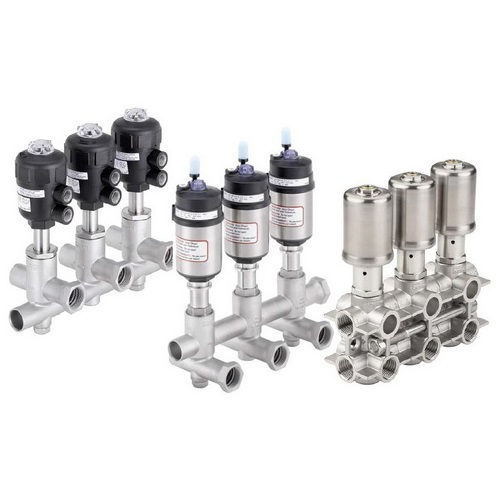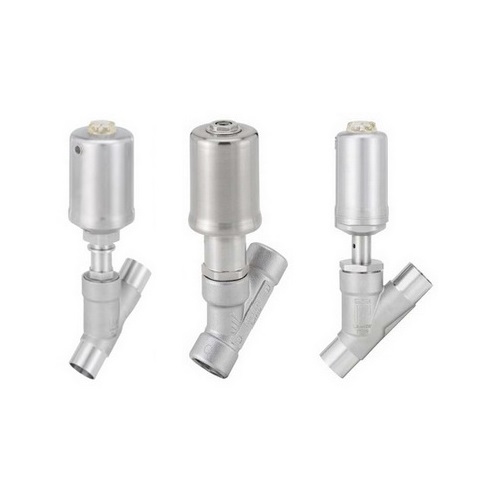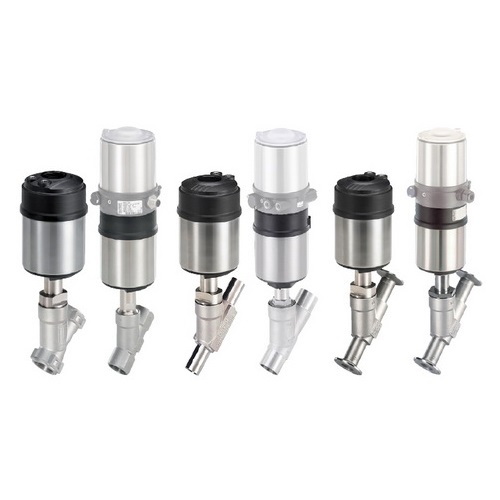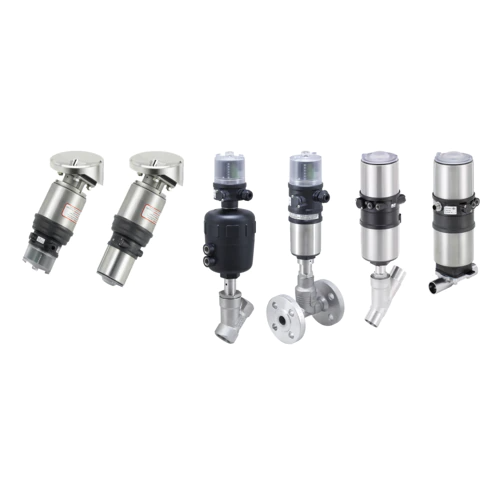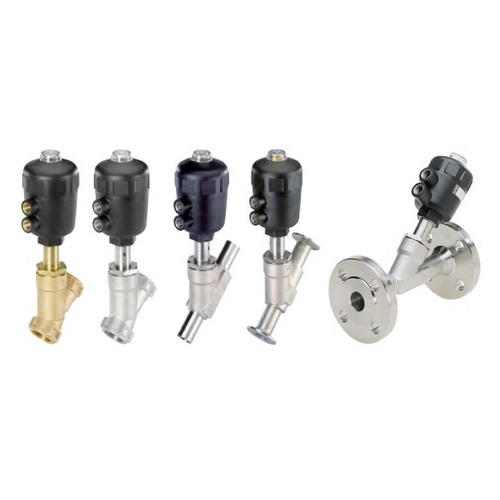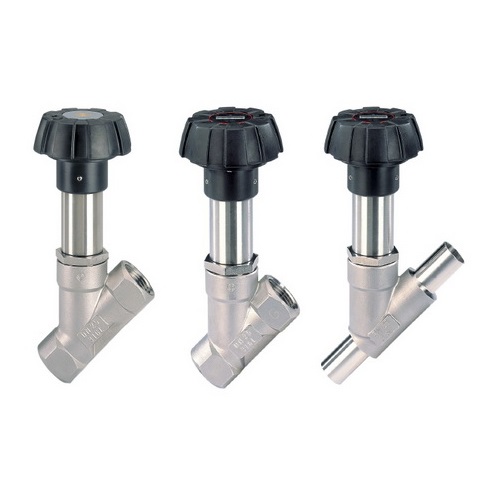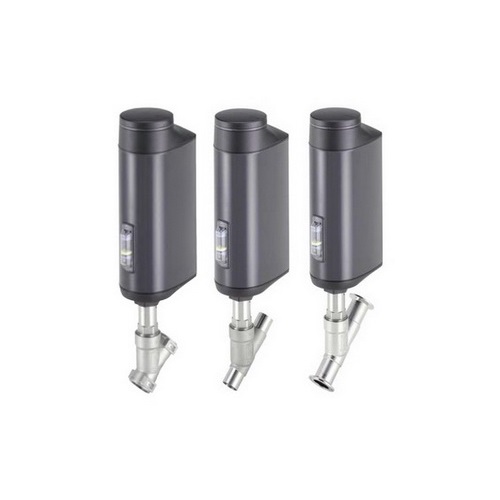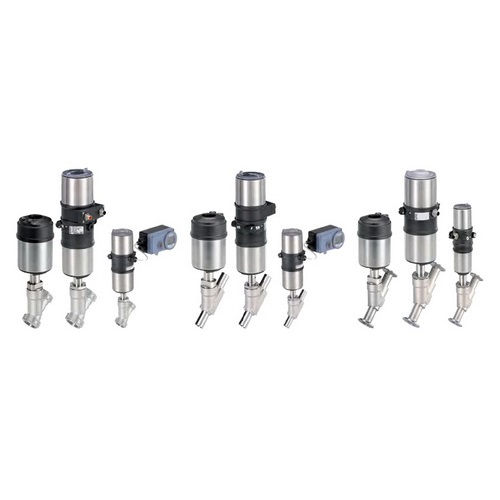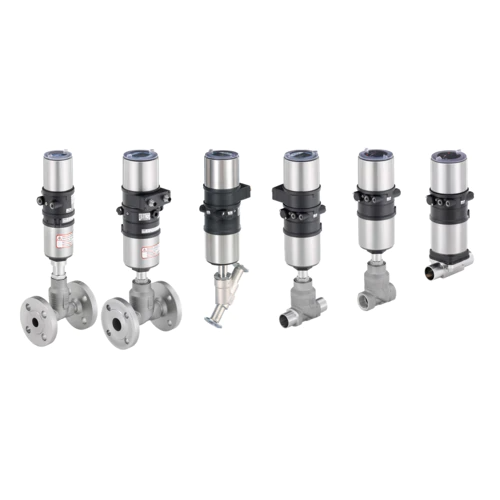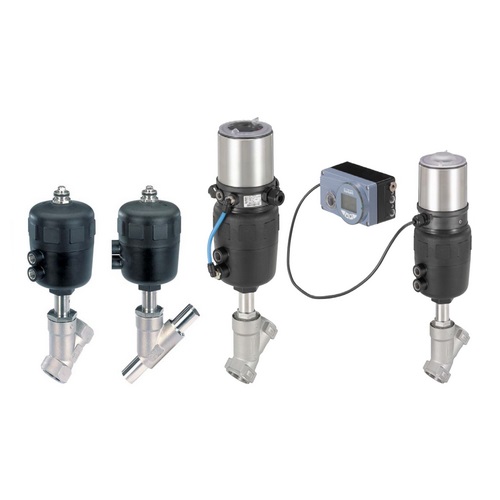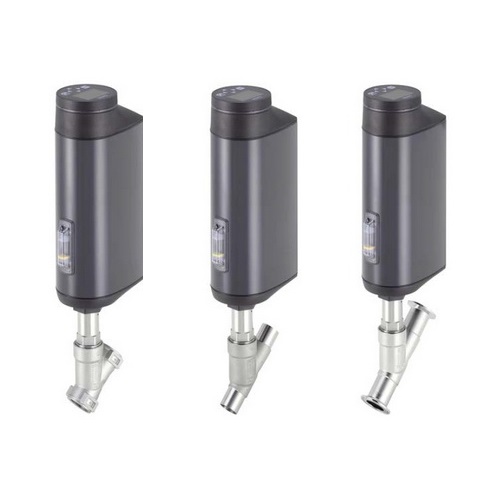Angle-Seat Valves
Type 8840 - Modular process valve cluster - distribution and collecting
Type 8840 comes with ready to install modules of tried and tested Bürkert process valves. The valve cluster, based on a modular valve body, allows different configurations. The individual parts are joined hermetically tight and in a very compact way. No installation effort for pipework, fittings or sealings is needed. For the sizes DN20 (¾") and DN25 (1") orbital welding is used. The smaller variants in DN10 are threaded together using trusted graphite seals. To avoid dangerous water hammer, all valves have the flow direction below the seat. This is made possible by the two variants for the fluidic main function distribution and collecting, mixing or feed. Depending on the requirement and preferred type of automation, it is possible to choose from different actuator variants. The robust CLASSIC actuators (in stainless steel or plastic) are controlled by a central valve island or by a pilot valve. The proven ELEMENT actuators allow a simple decentralized automation by using intelligent control heads Furthermore it is possible to expand the system by using continuous control valves, sensors, customer specific pipework or further accessories.
- Valve cluster ready for installation
- Compact design without any potential leakage
- No assembly effort
- No piping between the valves needed
- Trusted actuators for simple automation
Type 2060 - Pneumatically operated 2/2-way angle seat valve with stainless steel actuator
The pneumatically operated angle seat valve with stainless steel actuators fulfils the demands of tough process environments. Unrivalled life time and sealing integrity is guaranteed by the trusted self-adjusting spindle sealing. The stainless steel actuator has been designed for tough applications. Laser welding ensures it is both cleanable and robust. With a ducted exhaust air port, the actuator can be operated isolated from the environment to guarantee an optimum life time and hygiene. High flow rates are attained with the optimised stainless steel angle seat body. As part of the Bürkert process valve range a large accessory program is available. All wetted parts comply with the EC Directive 1935/2004, variants with FDA conformity are available on request, also explosion proof variants are available.
- Flow optimised stainless steel body with various line connections
- Trusted components for the longest life time
- Stainless steel actuator suitable for demanding environments
- Modular accessory program with stroke limitation and position feedback available
Type 2100 - Pneumatically operated 2/2 way angle seat valve ELEMENT for decentralized automation
The angle seat valve Type 2100 is specially optimized for decentralized process automation and fulfils tough criteria for process environments. The design enables the easy integration of automation units whether they are electrical/ optical position feedback, pneumatic control units or an integrated fieldbus interface. Unrivalled cycle life and sealing integrity is guaranteed by the proven self adjusting spindle packing with V-seals. The fully integrated system has a compact and smooth design, integrated pneumatic lines, IP65/67, NEMA Type 4X protection class and superior chemical resistance.
- High flow rate
- Long service life
- Easy integration of automation units with ELEMENT
- Flow-optimized stainless steel housing with threaded, clamp or weld connection
- Suitable for 10 bar(g) steam
Type 8801 - ELEMENT On/Off Valve Systems with decentralized automation
The design of the System Type 8801 On/Off ELEMENT enables the easy integration of automation modules whether they are electrical/optical position feedback, pneumatic control units, an optional integrated fieldbus interface or even an explosion proof control head. The fully integrated system with valve and automation system has a compact and smooth design, integrated pneumatic lines, IP65/67/NEMA4X protection class and superior chemical resistance.
Type 2000 - Pneumatically operated 2/2 way angle seat valve CLASSIC
The externally piloted angle seat valve is operated with a single or double – acting piston actuator. The actuator is available in two different materials, depending on the ambient temperature. High flow rates are attained with the virtually straight flow path. The reliable self – adjusting packing gland provides high sealing integrity. These maintenance-free and robust valves can be retrofitted with a comprehensive range of accessories for position indication, stroke limitation or manual override.
- Stainless steel or gunmetal housing with threaded, clamped or welded connection
- Long service life
- High flow rate
- Robust actuators with modular accessory program
Type 2000/2702 Angle Seat Valve 2/2-Way, manually operated
Manually-operated angle-seat valve of the type series 2000/2702 are delivered as standard with threaded or weld end port connection. The 2000 with manual actuator without position indidator is used only for On/Off function. Type 2702 with manual actuator and position indicator is designed with a parabolic trim and therefore it can be used to control a defined flow.
- Position indication
- Adjustable flow rates
- Stainless steel valve body
- Compact industrial design with long service life
- Excellent seat tightness due to PTFE soft sealing
Type 3320 - Electromotive 2/2 way angle seat valve
The innovative Bürkert On/Off process valve Type 3320 is the solution when it comes to shut-off tasks under demanding operating conditions. The electromotive actuator with ball screw moves the swivel plate at a particulary high rate of 6 mm/s to its end position. Thereby it reacts almost instantaneously to process signals. If necessary, the safety position can be approached by an optional energy storage in case of power failure. The actuator and shut-off valve are adapted perfectly to each other with closed design and robust surface. This ensures the hygienic requirements of a fast and residue-free cleaning. Harsh environments are no problem for the Type 3320 because of the protection class IP65 / IP67 and its high impact and vibration resistance. Unrivalled cycle life and sealing integrity is guaranteed by the proven self adjusting spindle packing with exchangeable V-seals. The fieldbus suitable for Type 3320 provides many helpful functions for process monitoring, valve diagnostics and predictive maintenance and thus offers the decisive advantage of a modern process automation.
- Fail-safe position by energy storage
- Rapid flow shut off
- Weather and impact resistant design
- Designed according to hygienic demands
- Many diagnostic functions
Type 2300 - Pneumatically operated 2 way angle seat control valve ELEMENT
In line with Bürkert’s philosophy for modular valves and sensors the construction of Type 2300 angle-seat valve fulfils tough criteria for process environments. Unrivalled cycle life and sealing integrity is guaranteed by the proven self adjusting packing gland. The parabolic trim results in a flow characteristic approximately 35% larger than conventional control valves. It is available in either stainless steel on stainless steel or with a durable PTFE seal for tight shut-off. The design enables the easy integration of automation modules whether they are digital electropneumatic positioner or process controller. The fully integrated system has a compact and smooth design, integrated pneumatic lines, IP65/67, NEMA Type 4X protection class and superior chemical resistance. This system has been engineered for reliable accurate control in applications where high flow rate is an advantage.
- Excellent combination of good control characteristic and high flow rate
- Long service life
- Control units can be mounted directly without external tubing
- Stainless steel housing with thread, clamp and weld end connection
Type 8802 - ELEMENT continuous control valve systems
The design of the System Type 8802 continuous ELEMENT enables the easy integration of digital automation modules whether they are simple Positioner Basic, high-capacity Positioner with optional integrated fieldbus interface or even a digital process controller with easy handling thanks to the backlighting of the graphics display. The fully integrated system with control valve and automation system has a compact and smooth design, integrated pneumatic lines, IP65/67/NEMA 4X protection class and superior chemical resistance.
- Extended warranty of two years
- Integrated automation with leading technology
- High cycle life and maintenance-free operation
- Excellent control characteristics, especially angle seat and globe valve
Type 2702 - Pneumatically operated 2-way angle seat control valve
The 2702 pilot valve consists of an 316L angle seat body with a rugged pneumatic piston actuator. The parabolic valve disc results in a flow capacity approximately 35% larger than conventional control valves. It is available in either stainless steel on stainless steel or with a durable PTFE seal for tight shut-off. Type 2702 can be actuated by the positioners TopControl Continuous Type 8692/8693/8694 or SideControl Type 8635 or SideControl 8792/93 remote versions. The TopControl thus forms an optical and functional unit with the pneumatic actuator as a complete control valve system. This system has been engineered for reliable accurate control in applications where high flow rate is an advantage.
- Excellent control accuracy and high flow capacity
- Long service life
- Robust actuators with modular accessory program
- Stainless steel body with socket or weld connection
Type 3360 - Electromotive 2 way angle seat control valve
The innovative process controller Bürkert valve Type 3360 is the solution when it comes to control tasks under demanding operating conditions. The electromotive actuator with ball screw positions the control cone with highest precision. A unique feature is its high positioning speed of 6 mm/s, that reacts quasi delay-free to process signals, and can be varied according to customer demands. Pressure variations or shocks in the medium aren´t transferred to the valve position. If necessary, the safety position can be approached by an optional energy storage in case of power failure. Actuator and valve are adapted perfectly to each other with closed design and robust surface. This ensures the hygienic requirements of a fast and residue-free cleaning. Harsh environment are no problem for the Type 3360 because of the protection class IP65 / IP67 and its high impact and vibration resistance. Unrivalled cycle life and sealing integrity is guaranteed by the proven self adjusting spindle packing with exchangeable V-seals. The fieldbus suitable Type 3360 provides many helpful functions for process monitoring, valve diagnostics and predictive maintenance and thus offers the decisive advantage of a modern process automation.
- good and fast control
- weather, impact and vibration resistant design
- easy cleaning by its design according hygienic demands
- position controller and process controller available

